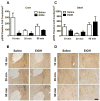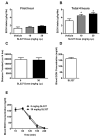Alcohol alters the activation of ERK1/2, a functional regulator of binge alcohol drinking in adult C57BL/6J mice
- PMID: 25703719
- PMCID: PMC4348173
- DOI: 10.1111/acer.12645
Alcohol alters the activation of ERK1/2, a functional regulator of binge alcohol drinking in adult C57BL/6J mice
Abstract
Background: Binge alcohol drinking is a particularly risky pattern of alcohol consumption that often precedes alcohol dependence and addiction. The transition from binge alcohol drinking to alcohol addiction likely involves mechanisms of synaptic plasticity and learning in the brain. The mitogen-activated protein kinase (MAPK) signaling cascades have been shown to be involved in learning and memory, as well as the response to drugs of abuse, but their role in binge alcohol drinking remains unclear. The present experiments were designed to determine the effects of acute alcohol on extracellular signaling-related kinases (ERK1/2) expression and activity and to determine whether ERK1/2 activity functionally regulates binge-like alcohol drinking.
Methods: Adult male C57BL/6J mice were injected with ethanol (EtOH) (3.0 mg/kg, intraperitoneally) 10, 30, or 90 minutes prior to brain tissue collection. Next, mice that were brought to freely consume unsweetened EtOH in a binge-like access procedure were pretreated with the MEK1/2 inhibitor SL327 or the p38 MAPK inhibitor SB239063.
Results: Acute EtOH increased pERK1/2 immunoreactivity relative to vehicle in brain regions known to be involved in drug reward and addiction, including the central amygdala and prefrontal cortex. However, EtOH decreased pERK1/2 immunoreactivity relative to vehicle in the nucleus accumbens core. SB239063 pretreatment significantly decreased EtOH consumption only at doses that also produced nonspecific locomotor effects. SL327 pretreatment significantly increased EtOH, but not sucrose, consumption without inducing generalized locomotor effects.
Conclusions: These findings indicate that ERK1/2 MAPK signaling regulates binge-like alcohol drinking. As alcohol increased pERK1/2 immunoreactivity relative to vehicle in brain regions known to regulate drug self-administration, SL327 may have blocked this direct pharmacological effect of alcohol and thereby inhibited the termination of binge-like drinking.
Keywords: Alcohol; Amygdala; Binge Drinking; ERK1/2; MAP Kinase; Nucleus Accumbens.
Copyright © 2015 by the Research Society on Alcoholism.
Figures






Similar articles
-
Operant ethanol self-administration increases extracellular-signal regulated protein kinase (ERK) phosphorylation in reward-related brain regions: selective regulation of positive reinforcement in the prefrontal cortex of C57BL/6J mice.Psychopharmacology (Berl). 2015 Sep;232(18):3417-30. doi: 10.1007/s00213-015-3993-z. Epub 2015 Jun 28. Psychopharmacology (Berl). 2015. PMID: 26123321 Free PMC article.
-
Increased operant responding for ethanol in male C57BL/6J mice: specific regulation by the ERK1/2, but not JNK, MAP kinase pathway.Psychopharmacology (Berl). 2009 May;204(1):135-47. doi: 10.1007/s00213-008-1444-9. Epub 2009 Jan 6. Psychopharmacology (Berl). 2009. PMID: 19125235 Free PMC article.
-
Binge-like consumption of ethanol and other salient reinforcers is blocked by orexin-1 receptor inhibition and leads to a reduction of hypothalamic orexin immunoreactivity.Alcohol Clin Exp Res. 2015 Jan;39(1):21-9. doi: 10.1111/acer.12591. Alcohol Clin Exp Res. 2015. PMID: 25623402 Free PMC article.
-
Bupropion, Alone and in Combination with Naltrexone, Blunts Binge-Like Ethanol Drinking and Intake Following Chronic Intermittent Access to Ethanol in Male C57BL/6J Mice.Alcohol Clin Exp Res. 2019 May;43(5):783-790. doi: 10.1111/acer.13992. Epub 2019 Mar 19. Alcohol Clin Exp Res. 2019. PMID: 30817015 Free PMC article.
-
The neurobiology of binge-like ethanol drinking: evidence from rodent models.Physiol Behav. 2012 Jun 6;106(3):325-31. doi: 10.1016/j.physbeh.2011.12.026. Epub 2012 Jan 8. Physiol Behav. 2012. PMID: 22245775 Free PMC article. Review.
Cited by
-
Operant ethanol self-administration increases extracellular-signal regulated protein kinase (ERK) phosphorylation in reward-related brain regions: selective regulation of positive reinforcement in the prefrontal cortex of C57BL/6J mice.Psychopharmacology (Berl). 2015 Sep;232(18):3417-30. doi: 10.1007/s00213-015-3993-z. Epub 2015 Jun 28. Psychopharmacology (Berl). 2015. PMID: 26123321 Free PMC article.
-
Using In Vitro Electrophysiology to Screen Medications: Accumbal Plasticity as an Engram of Alcohol Dependence.Int Rev Neurobiol. 2016;126:441-65. doi: 10.1016/bs.irn.2016.02.018. Epub 2016 Mar 24. Int Rev Neurobiol. 2016. PMID: 27055622 Free PMC article.
-
Alcohol drinking exacerbates neural and behavioral pathology in the 3xTg-AD mouse model of Alzheimer's disease.Int Rev Neurobiol. 2019;148:169-230. doi: 10.1016/bs.irn.2019.10.017. Epub 2019 Oct 23. Int Rev Neurobiol. 2019. PMID: 31733664 Free PMC article. Review.
-
RACK1 promotes maintenance of morphine-associated memory via activation of an ERK-CREB dependent pathway in hippocampus.Sci Rep. 2016 Feb 2;6:20183. doi: 10.1038/srep20183. Sci Rep. 2016. PMID: 26830449 Free PMC article.
-
Nicotine self-administration and ERK signaling are altered in RasGRF2 knockout mice.Front Pharmacol. 2022 Sep 2;13:986566. doi: 10.3389/fphar.2022.986566. eCollection 2022. Front Pharmacol. 2022. PMID: 36120353 Free PMC article.
References
-
- ALEGRIA AA, HASIN DS, NUNES EV, LIU SM, DAVIES C, GRANT BF, BLANCO C. Comorbidity of generalized anxiety disorder and substance use disorders: results from the National Epidemiologic Survey on Alcohol and Related Conditions. The Journal of clinical psychiatry. 2010;71:1187–95. quiz 1252-3. - PMC - PubMed
-
- AROOR AR, SHUKLA SD. MAP kinase signaling in diverse effects of ethanol. Life sciences. 2004;74:2339–64. - PubMed
-
- BACHTELL RK, TSIVKOVSKAIA NO, RYABININ AE. Alcohol-induced c-Fos expression in the Edinger-Westphal nucleus: pharmacological and signal transduction mechanisms. The Journal of pharmacology and experimental therapeutics. 2002;302:516–24. - PubMed
Publication types
MeSH terms
Substances
Grants and funding
LinkOut - more resources
Full Text Sources
Other Literature Sources
Research Materials
Miscellaneous

